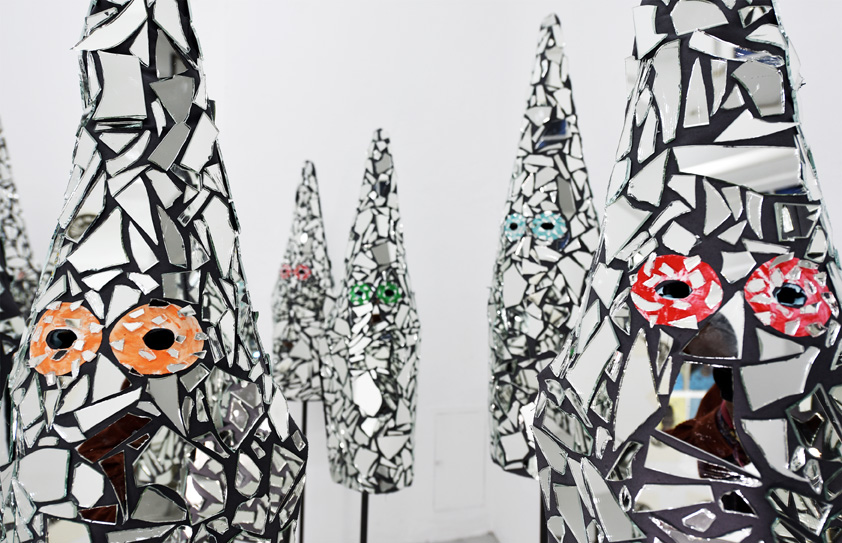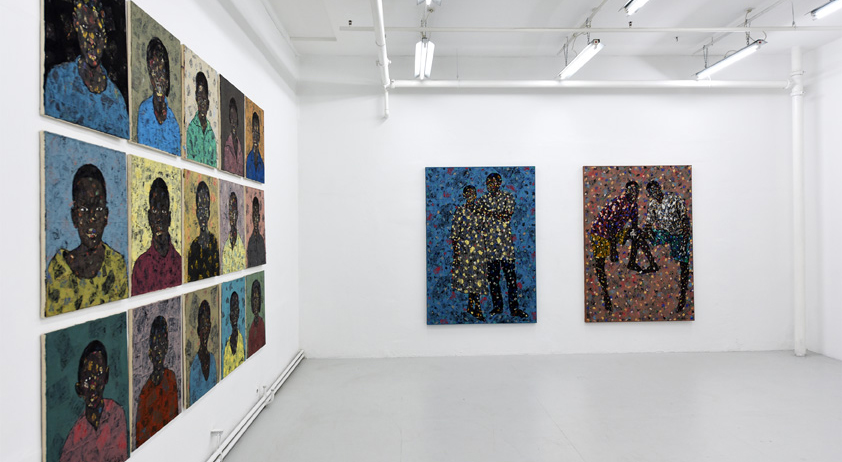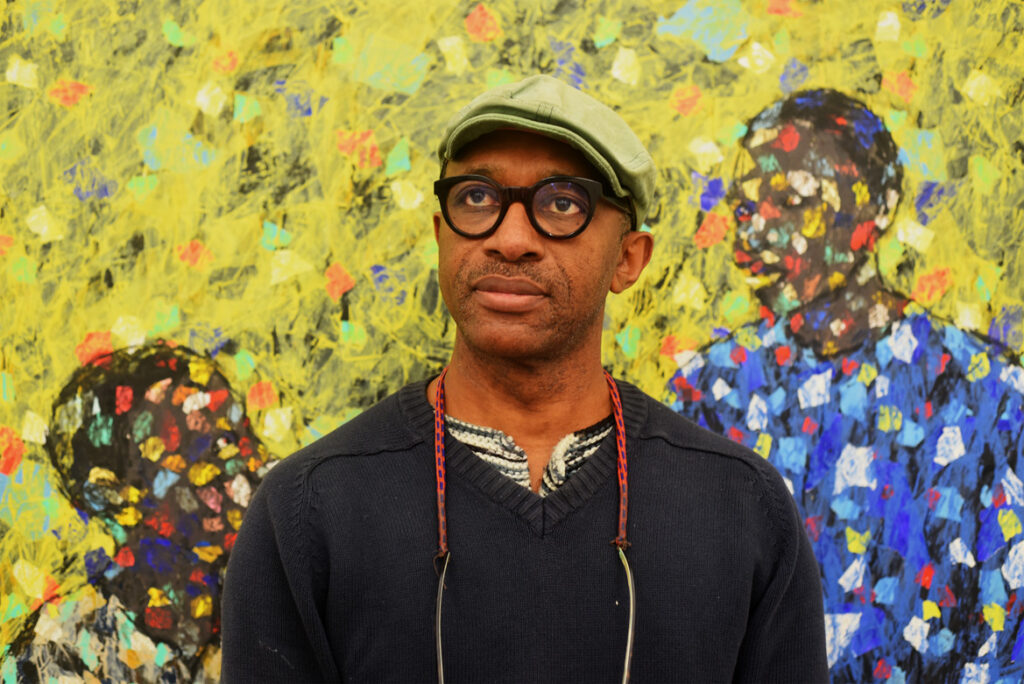Born 1968, Emeka Udemba studied art and art education at University of Lagos. After finishing his studies in the Nigerian metropolis and having his first successful exhibition at Goethe-Institut in Lagos in 1994, the artist got the opportunity to move to Freiburg (Breisgau) in Germany. Working between Nigeria and Germany Udemba has exhibited across Europe, Africa and Latin America. In 2002 Emeka Udemba received an invitation to participate in the legendary Documenta 11. Artistic director Okwui Enwezor and a team of six other co-curators of the Documenta 11 in one of the five platforms, platform 4 Under Siege: Four African Cities, Freetown, Johannesburg, Kinshasa, Lagos presented in Nigeria in march 2002. Udemba’s contribution to platform 4, his video installation Lost dreams, deals with the contradictions in postcolonial Africa.
With installation art, photography, performance art, video art and painting, Emeka Udemba created for himself a mixture of different artistic modes of expression. Soon he established an artistic presence in Europe and later founded an art space in Lagos to support younger artists. In 2013 he started painting his characteristic portraits, which play a multiple game with identities. His portrayed characters who float within a space of speculation and discoveries.
„I am interested in the idea of a space without endings, of a space without boundaries, which is not defined by exterior forces about who you are or where you belong to”, once he said. “My characters are situated in a space without delimitations. They are free to think what they like to think”.
Emeka Udemba asks about the perception and visualization of the „other“. His work captures the complexity of being „different“, and confronts issues of race and identity. This might also have been a motivation for his project Telling Stories in 2017, which was presented at Africa Alive Festival in Frankfurt, within the thematic scope of migration. For this project Emeka Udemba asked refugees and migrants in Germany to be photographed with German symbols they personally chose. Also in this case the artist was interested in the question to what extent the persons portrayed by him are able to create for themselves spaces and identify with in Germany.
We first met Emeka Udemba in January 2017 at the vernissage of Telling Stories at Filmforum Höchst in Frankfurt on the Main, and four years later I talked to him on the phone.
There is fiction in the space between
the lines on your page of memories
write it down but it doesn’t mean
you’re not just telling stories
there is fiction in the space between
you and reality
you will do and say anything
to make your everyday life
seem less mundane
there is fiction in the space between
you and me
there’s a science fiction in the space between
you and me
a fabrication of a grand scheme
where i am the scary monster
i eat the city and as i leave the scene
in my spaceship i am laughing
in your remembrance of your bad dream
there’s no one but you standing
leave the pity and the blame
for the ones who do not speak
you write the words to get respect and compassion
and for posterity
you write the words and make believe
there is truth in the space between
there is fiction in the space between
you and everybody
give us all what we need
give us one more sad sordid story
but in the fiction of the space between
sometimes a lie is the best thing
sometimes a lie is the best thing
Cornelia Wilß: In your work you are melting Western with African motifs. You reinterpret traditionally utilized materials you know from Africa and with them you create installations which escape from a superficial glance and a fast interpretation. Layer after layer you twist the original motif or the existing body into a new existence. That is why you frequently have been asked whether you consider yourself a „hybrid“ artist…
Emeka Udemba: Well. I understand this categorization as discrimination. It is just natural that I integrate elements from my culture into my artistic work. It is a very European mindset to press everything systematically or sorted by categories into a hierarchical order. It is an expression of European dominance behavior. The West keeps on claiming its sole representation for Modern Art or for the Avant-garde. Other perspectives simply get reduced to something one believes to know or to be aware of. In addition, everything which is not Western, in general, is considered as traditional or even as primitive. I often experienced, that works of artists from Africa not necessarily receive high esteem or even any perception. If only the artist’s name sounds African, the attitude of the public and the expectations for esthetics and semiotics change. The colours of Africa must be glowing, be warm and conform to the images and ideas about Africa that people here imagine, right? For me, art should be a platform, not only to express beauty, but also to educate and inform – no matter what the artist’s background is. In this sense the public should be open minded to new experiences and to exchanges. It is important that we remove this concrete wall made of expectations and projections.
Of course I am influenced by my origin, and sometimes I do work with material that bears a meaning in my culture. My artistic creation however plays and deals with the reality of my identity. My works address the question of „being“ and how we perceive ourselves and the others.
Many artists from Africa here in Germany often are only perceived as African artists, as if Africa is part of another planet. I am proud of my roots in Africa. I am an artist from Africa, but I am not an African artist!

I am an artist from Africa, but I am not an African artist!
Is this something artists from Africa usually experience in Germany? Or is it a fundamental problem?
I think this is an experience made by all of us, no matter where we are heading to or wherever we are working in the whole Western world.
For example, if an artist from Germany picks up elements of African art, he will be hailed as a cosmopolitan artist. But this is nothing new, just have a look at Dadaism or at Picasso … This is exactly what they did. And still today this is triggering a maniac hype.
If an artist born in Africa is working that way, he does not cope with the expectations of the so called art scene. This artist remains an authentic African artist related to traditions!
Which is the role curators are hereby playing?
I observe that only few curators hit the road and look out for new creative artists on the African continent. Most of them just flip through the catalogues of the biennials, and from that portfolio they select the artists with who they like to organize an exposition. Very rarely they travel to Africa themselves to see what is happening there. That is the reason why the artifacts presented here mostly show a recycling of the unvarying same.
What about the art market?
Gallery owners are interested in finished products and want to present the work at art expositions and at biennials. Of course they are speculating for a rising value of your art in the next years. Maybe in former times galleries pursued another kind of ethics. That someone believes in you and accompanies you… This attitude is now quite uncommon. In former times probably there may have been more patrons, more art lovers who gave you support.
In Germany in comparison there exist many subsidies to be tapped by artists. But that is like playing the lottery. There are many artists who compete for these subsidies, and of course this is normal. Well, you just swing from one project to the next. Most of us have two or three side jobs to survive. It is my way to develop a platform for myself, independent from an institutional presence or representation. You cannot keep waiting till somebody discovers you.
This is not that easy in Freiburg in comparison to hip Berlin for example?
I love living in Freiburg. The town is international, there is a pleasant climate, the Black Forest is nearby, and France (the artist is laughing loud). But Freiburg is not a stronghold of Contemporary Art. I always had to strive for contacts. I do a lot of traveling and that is one way of networking. For example I travel a lot to Berlin, where you find many art institutions and where you can meet many artists. One important contact point for Contemporary Art from Africa and other regions of the world is the SAVVY Contemporary, but elsewhere in Germany, galleries presenting a portfolio with African artists are scarce.
You have participated in the official program of Dak’Art 2018 that following the French Afro-Caribbean writer Aimé Césaire, celebrated Pan-Africanism. Developing a Pan African platform with artists in Africa and in the diaspora, would that serve as a promising approach to get rid of Western dominance?
I often stay in Nigeria and I know this country quite well. Indeed you may actually notice a growing self-awareness. People are more enlightened. Of course, one may wish for that, but the reality is different. Take for example a close look at the development of Asia in the art market, it is obvious that many artists have gained acceptance in Europe. But what is the reason? This reflects the economic rise of China and other Asian countries. Economic success and if and how a society develops and the relevance of art in the social space are connected. In Nigeria as well as in many other African countries there are now new-rich people who are supporting art collections or galleries. You definitely can notice an esteem for the own creative industry. But it is still a long way for Africa to become independent from the West. Biennials like those in Lagos and in Dakar or in other African urban centers often to a large extent are funded from outside. These external funders often take influence on how these art events are presented.
Independent art space
In 2014, in Lagos, you initiated the project MMMoCA (Molue Mobile Museum of Contemporary Art-Projekts), a museum of contemporary art on wheels. What is the idea behind this project?
The idea of MMMoCA questions the conventional status of museums as archive centered cultural institutions. It puts into question the issue of „cultural elitism“, hence the cultural scene mostly is located in the upscale quarters of our cities and municipalities.
MMMoCA serves as a platform for critical contemporary artistic practices, experiences and reflections, in order to bring people together through creative activities and discourses in a social space accessible for everybody. One could say, the Molue is a mobile laboratory for creative exchange with the participation of international as well as of local artists [ed.: Aderemi Adegbite, Ayo Akinwande, Massira Toure, Angelo Dakouo, Clara Aden, Monsuru Alashe, Yamferlinos, Lukman Tadeyo, Emeka Udemba]. MMMoCA offers expositions, screenings, road trips, performances, talks and workshops, all open to the common public. The road trip to the Biennale of Dakar in 2018, at about 4.000 kilometers away from our starting point in Lagos, was a successful experiment of encounters and of presentation of art in a public space. MMMoCA is an independent art space that has come up to remain. This project is not completed. It keeps on moving. My plan is to transform a number of other decommissioned Molue commuter busses to extensions and to parts of the network of such kind of mobile museums. We are searching for sponsors to finance each module of the Molue Mobile Museum.
One could consider this an alternative concept to established museums?
Exactly! The present conceptions of museums in Africa are copies of a European concept that is not appropriate in the African context and simply just does not work there. One problem is the insufficient infrastructure of the museums, but this only one part why I think, we have to turn upside down the whole conception. In my view, museums in Africa often are just empty sterile buildings, far and away from the needs and experiences of ”ordinary” people. It is elitist to assume, that people in our countries are visiting museums because they want to see the items exposed. There is a need to change completely the institution museum as an element of a cultural offering, and to transform theses spaces into productive spots of knowledge and of encounter. This is exactly the opportunity the mobile museum provides.
Criticizing present concepts of museums, what would you consider as starting points for the exhibition of the objects European museums are returning to the countries and the regions of their origin?
In my view this is an issue that at present is discussed very emotionally. I understand that in Western countries it is a matter of recognizing that these objects once belonged to Africans and are part of African culture and identity. For many Africans it is a highly sensitive issue, and the Europeans have to accept this claim as part of their colonial history and their colonial debt.
I like to object however that the factual reality on site is quite different. Where should we display these objects? We need more time to build up appropriate institutions. One of the factors obviously to take into account is the technical expertise of conservators and the knowledge of art scholars. This is why I would prefer focussing more on cooperative models, with museums that join in precisely defined mutual and reliable cooperation and, for example, engage jointly in conceptualizing expositions. Then, objects could be shown for some time in Lagos, and later in Berlin. And afterwards in another place. On one hand we need very precise regulations, but on the other hand we also have to understand that all together we form one single mankind and that we are inspiring each other mutually. Solely counting on symbolic acts will not take us any step forward. In Africa we have to make efforts to instigate positive changes.
Which are your present projects?
At this moment I am working on several projects. Because of the corona virus pandemic, I am forced to concentrate on painting. One of my last works presented by Galerie für Gegenwartskunst (Gallery for Contemporary Art) in Freiburg, had been the exposition Another Day in Paradise at Regionale 21 in E-Werk, located in Freiburg (www.swr.de/kunst-und-ausstellung).

My new project Intended Goodness was planned to start this year, but got postponed. By means of items from German colonial era, the project deals with the reappraisal of our common history that has been causing its impacts right to the present days. Have you ever seen a „Nickneger“? This is a donation box with a Black figure nodding when money is inserted, it was quite popular in German churches, with the donation destined to overseas mission work. My aim is to reappraise our common colonial history through an artistic treatment of such objects shaped by colonialism. That will be a long and slow process. On our African part we must take more action to tell the History from our perspective.
Translation: Stefanie Karg


